
A | B | C | D | E | F | G | H | CH | I | J | K | L | M | N | O | P | Q | R | S | T | U | V | W | X | Y | Z | 0 | 1 | 2 | 3 | 4 | 5 | 6 | 7 | 8 | 9
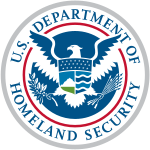 | |
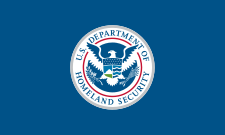 Flag of the U.S. Department of Homeland Security | |
 Headquarters of the U.S. Department of Homeland Security in Washington D.C. | |
| Agency overview | |
|---|---|
| Formed | November 25, 2002 |
| Jurisdiction | U.S. federal government |
| Headquarters | St. Elizabeths West Campus, Washington, D.C., U.S. 38°51′17″N 77°00′00″W / 38.8547°N 77.0000°W |
| Employees | 240,000 (2018)[1] |
| Annual budget | $51.672 billion (FY 2020)[2] |
| Agency executives | |
| Child agency |
|
| Website | dhs.gov |
"The DHS March" | |
| United States Armed Forces |
|---|
 |
| Executive departments |
| Staff |
| Military departments |
| Military services |
| Command structure |
The United States Department of Homeland Security (DHS) is the U.S. federal executive department responsible for public security, roughly comparable to the interior or home ministries of other countries. Its stated missions involve anti-terrorism, border security, immigration and customs, cyber security, and disaster prevention and management.[3]
It began operations on March 1, 2003, after being formed as a result of the Homeland Security Act of 2002, enacted in response to the September 11 attacks. With more than 240,000 employees,[1] DHS is the third-largest Cabinet department, after the Departments of Defense and Veterans Affairs.[4] Homeland security policy is coordinated at the White House by the Homeland Security Council. Other agencies with significant homeland security responsibilities include the Departments of Health and Human Services, Justice, and Energy.
History
Creation
In response to the September 11 attacks, President George W. Bush announced the establishment of the Office of Homeland Security (OHS) to coordinate "homeland security" efforts. The office was headed by former Pennsylvania Governor Tom Ridge, who assumed the title of Assistant to the President for Homeland Security. The official announcement states:
The mission of the Office will be to develop and coordinate the implementation of a comprehensive national strategy to secure the United States from terrorist threats or attacks. The Office will coordinate the executive branch's efforts to detect, prepare for, prevent, protect against, respond to, and recover from terrorist attacks within the United States.[5]
Ridge began his duties as OHS director on October 8, 2001.[6] On November 25, 2002, the Homeland Security Act established the Department of Homeland Security to consolidate U.S. executive branch organizations related to "homeland security" into a single Cabinet agency. The Gilmore Commission, supported by much of Congress and John Bolton, helped further solidify need for the department. The DHS incorporated the following 22 agencies.[7]
List of incorporated agencies
| Original agency | Original department | New agency or office after transfer |
|---|---|---|
| U.S. Customs Service | Treasury | U.S. Customs and Border Protection U.S. Immigration and Customs Enforcement |
| Immigration and Naturalization Service | Justice | U.S. Customs and Border Protection U.S. Immigration and Customs Enforcement U.S. Citizenship and Immigration Services |
| Federal Protective Service | General Services Administration | Management Directorate |
| Transportation Security Administration | Transportation | Transportation Security Administration |
| Federal Law Enforcement Training Center | Treasury | Federal Law Enforcement Training Center |
| Animal and Plant Health Inspection Service (part) |
Agriculture | U.S. Customs and Border Protection |
| Federal Emergency Management Agency | none | Federal Emergency Management Agency (FEMA) |
| Strategic National Stockpile National Disaster Medical System |
Health and Human Services | Originally assigned to FEMA, Returned to HHS, July 2004 |
| Nuclear Incident Response Team | Energy | Responsibilities distributed within FEMA |
| Domestic Emergency Support Team | Justice | Responsibilities distributed within FEMA |
| Center for Domestic Preparedness | Justice (FBI) | Responsibilities distributed within FEMA |
| CBRN Countermeasures Programs | Energy | Science & Technology Directorate |
| Environmental Measurements Laboratory | Energy | Science & Technology Directorate |
| National Biological Warfare Defense Analysis Center |
Defense | Science & Technology Directorate |
| Plum Island Animal Disease Center | Agriculture | Science & Technology Directorate |
| Federal Computer Incident Response Center | General Services Administration | US-CERT, Office of Cybersecurity and Communications National Programs and Preparedness Directorate (now CISA) |
| National Communications System | Defense | Office of Cybersecurity and Communications National Programs and Predaredness Directorate |
| National Infrastructure Protection Center | Justice (FBI) | Office of Operations Coordination Office of Infrastructure Protection |
| Energy Security and Assurance Program | Energy | Office of Infrastructure Protection |
| U.S. Coast Guard | Transportation | U.S. Coast Guard |
| U.S. Secret Service | Treasury | U.S. Secret Service |
According to political scientist Peter Andreas, the creation of DHS constituted the most significant government reorganization since the Cold War[8] and the most substantial reorganization of federal agencies since the National Security Act of 1947 (which had placed the different military departments under a secretary of defense and created the National Security Council and Central Intelligence Agency). DHS constitutes the most diverse merger of federal functions and responsibilities, incorporating 22 government agencies into a single organization.[9] The founding of the DHS marked a change in American thought towards threats. Introducing the term "homeland" centers attention on a population that needs to be protected not only against emergencies such as natural disasters but also against diffuse threats from individuals who are non-native to the United States.[10]
Prior to the signing of the bill, controversy about its adoption was focused on whether the Federal Bureau of Investigation and the Central Intelligence Agency should be incorporated in part or in whole (neither were included). The bill was also controversial for the presence of unrelated "riders", as well as for eliminating certain union-friendly civil service and labor protections for department employees. Without these protections, employees could be expeditiously reassigned or dismissed on grounds of security, incompetence or insubordination, and DHS would not be required to notify their union representatives. The plan stripped 180,000 government employees of their union rights.[11] In 2002, Bush officials argued that the September 11 attacks made the proposed elimination of employee protections imperative.[12]
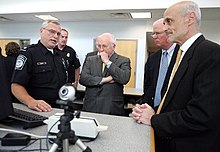
Congress ultimately passed the Homeland Security Act of 2002, and President Bush signed the bill into law on November 25, 2002. It was the largest U.S. government reorganization in the 50 years since the United States Department of Defense was created.
Tom Ridge was named secretary on January 24, 2003, and began naming his chief deputies. DHS officially began operations on January 24, 2003, but most of the department's component agencies were not transferred into the new department until March 1.[5]
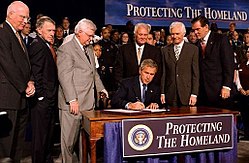
After establishing the basic structure of DHS and working to integrate its components, Ridge announced his resignation on November 30, 2004, following the re-election of President Bush. Bush initially nominated former New York City Police Department commissioner Bernard Kerik as his successor, but on December 10, Kerik withdrew his nomination, citing personal reasons and saying it "would not be in the best interests" of the country for him to pursue the post.
Changes under Secretary Chertoff
On January 11, 2005, President Bush nominated federal judge Michael Chertoff to succeed Ridge. Chertoff was confirmed on February 15, 2005, by a vote of 98–0 in the U.S. Senate and was sworn in the same day.[5]
In February 2005, DHS and the Office of Personnel Management issued rules relating to employee pay and discipline for a new personnel system named MaxHR. The Washington Post said that the rules would allow DHS "to override any provision in a union contract by issuing a department-wide directive" and would make it "difficult, if not impossible, for unions to negotiate over arrangements for staffing, deployments, technology and other workplace matters".[12] In August 2005, U.S. District Judge Rosemary M. Collyer blocked the plan on the grounds that it did not ensure collective-bargaining rights for DHS employees.[12] A federal appeals court ruled against DHS in 2006; pending a final resolution to the litigation, Congress's fiscal year 2008 appropriations bill for DHS provided no funding for the proposed new personnel system.[12] DHS announced in early 2007 that it was retooling its pay and performance system and retiring the name "MaxHR".[5] In a February 2008 court filing, DHS said that it would no longer pursue the new rules, and that it would abide by the existing civil service labor-management procedures. A federal court issued an order closing the case.[12]
Trump administration
On November 16, 2018, President Donald Trump signed the Cybersecurity and Infrastructure Security Agency Act of 2018 into law, which elevated the mission of the former DHS National Protection and Programs Directorate and established the Cybersecurity and Infrastructure Security Agency.[13] In fiscal year 2018, DHS was allocated a net discretionary budget of $47.716 billion.[2]
Biden administration
In 2021, the Department of Justice began carrying out an investigation into white supremacy and extremism in the DHS ranks.[14]
DHS also halted large-scale immigration raids at job sites, saying in October 2021 that the administration was planning "a new enforcement strategy to more effectively target employers who pay substandard wages and engage in exploitative labor practices."[15]
Function
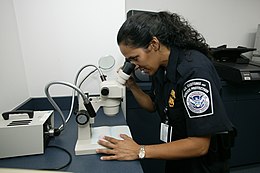

Whereas the Department of Defense is charged with military actions abroad, the Department of Homeland Security works in the civilian sphere to protect the United States within, at, and outside its borders. Its stated goal is to prepare for, prevent, and respond to domestic emergencies, particularly terrorism.[16] On March 1, 2003, DHS absorbed the U.S. Customs Service and Immigration and Naturalization Service (INS) and assumed its duties. In doing so, it divided the enforcement and services functions into two separate and new agencies: Immigration and Customs Enforcement and Citizenship and Immigration Services. The investigative divisions and intelligence gathering units of the INS and Customs Service were merged forming Homeland Security Investigations, the primary investigative arm of DHS. Additionally, the border enforcement functions of the INS, including the U.S. Border Patrol, the U.S. Customs Service, and the Animal and Plant Health Inspection Service were consolidated into a new agency under DHS: U.S. Customs and Border Protection. The Federal Protective Service falls under the National Protection and Programs Directorate.[citation needed]
Structure
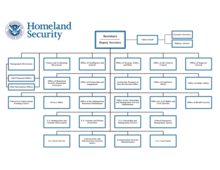
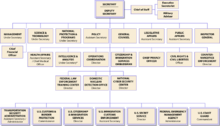
The Department of Homeland Security is headed by the Secretary of Homeland Security with the assistance of the Deputy Secretary. The department contains the components listed below.[17]
List of subordinate agencies
- Agencies
- United States Citizenship and Immigration Services: Processes and examines citizenship, residency, and asylum requests from aliens.
- U.S. Customs and Border Protection: Law enforcement agency that enforces U.S. laws along its international borders (air, land, and sea) including its enforcement of U.S. immigration, customs, and agriculture laws while at and patrolling between all U.S. ports-of-entry.
- U.S. Immigration and Customs Enforcement: Law enforcement agency divided into two bureaus:
- Homeland Security Investigations (HSI) investigates violations of more than 400 U.S. laws and gathers intelligence on national and international criminal activities that threaten the security of the homeland (Homeland Security Investigations); and
- Enforcement and Removal Operations (ERO) enforces administrative violations of the Immigration and Nationality Act by detaining, deporting, and removing violators of United States immigration law.
Text je dostupný za podmienok Creative Commons Attribution/Share-Alike License 3.0 Unported; prípadne za ďalších podmienok. Podrobnejšie informácie nájdete na stránke Podmienky použitia.
Antropológia
Aplikované vedy
Bibliometria
Dejiny vedy
Encyklopédie
Filozofia vedy
Forenzné vedy
Humanitné vedy
Knižničná veda
Kryogenika
Kryptológia
Kulturológia
Literárna veda
Medzidisciplinárne oblasti
Metódy kvantitatívnej analýzy
Metavedy
Metodika
Text je dostupný za podmienok Creative
Commons Attribution/Share-Alike License 3.0 Unported; prípadne za ďalších
podmienok.
Podrobnejšie informácie nájdete na stránke Podmienky
použitia.
www.astronomia.sk | www.biologia.sk | www.botanika.sk | www.dejiny.sk | www.economy.sk | www.elektrotechnika.sk | www.estetika.sk | www.farmakologia.sk | www.filozofia.sk | Fyzika | www.futurologia.sk | www.genetika.sk | www.chemia.sk | www.lingvistika.sk | www.politologia.sk | www.psychologia.sk | www.sexuologia.sk | www.sociologia.sk | www.veda.sk I www.zoologia.sk
